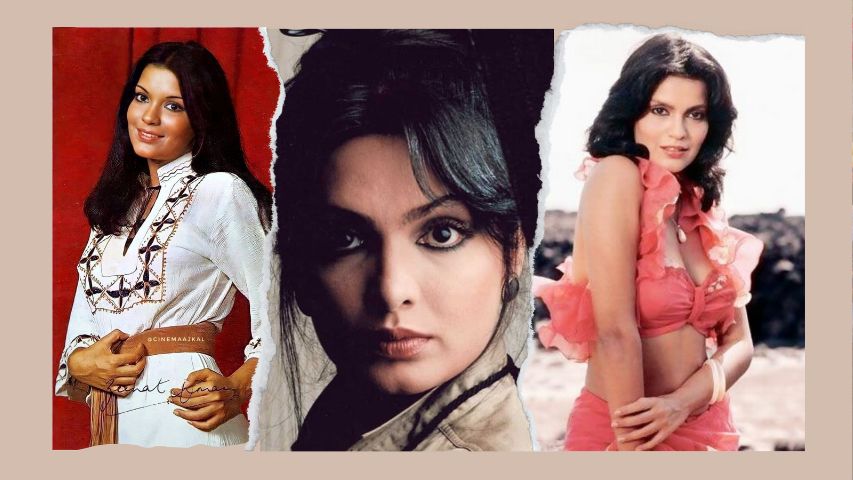-853X543.jpg)
MOVIES: THE ORIGINAL GLAM DIVAS OF BOLLYWOOD
by Pratik Majumdar February 25 2024, 12:00 am Estimated Reading Time: 4 mins, 34 secsBoth of them made relatively quiet debuts in the early ‘70s, Zeenat in OP Ralhan’s Hulchul (1971), and Parveen in BR Ishara’s Charitra (1973), but very soon carved out a distinct niche for themselves with successful films like Hare Rama Hare Krishna and Deewaar, writes Pratik Majumdar.
They were both divas who ruled the Hindi popular cinema landscape in the 1970s and ‘80s. Their on screen persona defied the existing conventional norms of what was expected from a Hindi cinema heroine of the times. Their off screen boldness and independence added to their on screen image too. In the age when conventionally accepted heroines like Hema Malini, Rekha and Reena Roy ruled the roost, the place created by Zeenat Aman and Parveen Babi can hardly be understated.
As the free-spirited pot-smoking Janice who grooved to the beats of RD Burman’s anthemic Dum Maaro Dum, Zeenat took the bewildered Indian film audience by storm. Never before perhaps had a sister’s role (rejected by most heroines) so completely overshadowed that of the heroine’s in a movie. With HRHK Zeenat was an overnight star.
Parveen’s portrayal of Anita in Deewaar, a strong-willed independent girl, caught in a helpless maze of crime and morality, brought her to the forefront of Hindi commercial cinema. Here was a ‘heroine’ who had no qualms about sharing a bed with the hero and sharing a smoke with him, too, afterwards. Gone were the days of tears in the ‘morning after’ scenario as Parveen’s portrayal of a modern woman caught the eye of the cine-goers. Zeenat’s and Parveen’s fame and popularity had an almost simultaneous genesis.
After HRHK, Zeenat became synonymous with the modern, independent woman on screen. Her performances in films like Yaadon Ki Baaraat (1973), Roti Kapada Aur Makaan (1974), and Don (1978) showcased her versatility and she seamlessly transitioned from glamorous roles to slightly more nuanced characters.
One of Zeenat Aman's unique attributes was her ability to challenge stereotypes both on and off-screen. She defied societal expectations by portraying strong, assertive women who were unapologetic about their choices. Additionally, her fashion sense and bold persona broke barriers, inspiring generations of actresses to embrace their individuality. When a scorching Zeenie Baby (as she was called by the media back then) came out of the seas in a white bikini, or crooned Aap Jaisa Koi in Qurbani (1981), the audience was well and truly seduced by her glamour and charm.

At the peak of her career Zeenat tried her hand at roles that gave her an opportunity to step beyond her glam-doll image. Her portrayal of Rupa in Satyam Shivam Sundaram (1978) was an attempt at that but yet again the bold costumes and those waterfall scenes in the movie overshadowed the character. Her attempt at a total de-glam role of an untouchable sweeper in mentor OP Ralhan’s Pyaas (1986) largely remained unnoticed as the film didn’t get a full-fledged all India release. Other such attempts also resulted in commercial failures such as Yaadon Ki Kasam (1985) and Bandhan Kachche Dhaagon Ka (1983). Zeenat it seemed could never ever shake off her sexy glam image, which was irrevocably set in the minds of her fans.
Like Zeenat, Parveen Babi challenged stereotypes and broke conventions through her choice of roles. Films like Amar Akbar Anthony (1977), Namak Halaal (1982), and Shaan (1980) further solidified her status as one of Bollywood's leading glamorous and ‘western’ actresses, a tag she shared with Zeenat Aman.
Parveen’s personal issues, mainly her mental health meant lesser screen appearance than her contemporaries. But she was a fine performer and when the filmmakers put their faith in her acting abilities, she never let them down. Be it her portrayal of a simple housewife in Hrishikesh Mukherjee’s Rang Birangi (a masterstroke in casting by Mukherjee where he cast Parveen as the housewife and Deepti Naval as the glam secretary), Esmayeel Shroff’s Dil Aakhir Dil Hai (1982) or Vinod Pande’s Yeh Nazdeekiyan (1982), Parveen never disappointed.
Despite having similar images, Zeenat and Parveen didn’t have too many films together. Ashanti (1982) and Mahaan (1983) would perhaps be the only two occasions when they came together. The former, a Hindi cinema take on Charlie’s Angels, had them interacting, whilst the latter had both of them as glamorous add-ons to multiple Amitabhs in the movie where they had precious little to do. Parveen did appear in a song sequence of Amjad Khan’s Ameer Aadmi Gareeb Aadmi, which had Zeenat Aman in the lead role but they didn’t have any scenes together. In fact Parveen was signed to play the heroine in the movie but after her decision to leave the country abruptly, the director replaced her with Zeenat Aman and kept the one song picturised on her in the film.
Zeenat Aman and Parveen Babi were trailblazers who shared similarities in their iconic status and versatility, both of them possessed unique attributes that made them stand out in their own right. Their contributions to Indian cinema continue to be celebrated and remembered, inspiring generations of actresses to follow in their footsteps.
And for fans like us, Chura Liya Hai Tumne Jo Dil Ko and Jawani Jaaneman Haseen Dilruba will be musical reminders of the glam-icons that were Zeenat Aman and Parveen Babi.




-173X130.jpg)
-173X130.jpg)
-173X130.jpg)


-173X130.jpg)

-173X130.jpg)